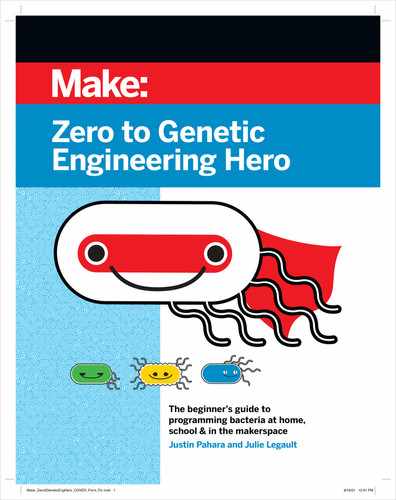
116 Zero to Genetic Engineering Hero - Chapter 4 - Genetic Engineering Your E. coli Cells
Summary and What’s Next?
In Chapter 4, you explored the Basic Operating Condi-
tions of a Cell, as well as the rst step in the Three Steps
to Microfacturing: Transcription. Here is a summary of
the transcription process:
1.
A sigma factor (protein) bumping around in the
cell binds to the non-coding promoter of the DNA
(+) strand. Because there are two strands that form
the DNA helix, the (+) strand can be either strand
as decided by the genetic engineer and therefore
the RNA polymerase can point in either direction.
2.
Because the sigma factor is able to bind to both
the DNA promoter and the RNA polymerase, once
attached, the sigma factor ‘recruits’ the rest of the
RNA polymerase machinery to bind to the DNA.
There are many copies of RNA polymerase in the
cell at any given moment.
3.
With the template strand, RNA polymerase reads
a short piece of the DNA and transcribes an initia-
tion RNA sequence - locking the RNA polymerase
onto the DNA sequence due to the A-U or C-G or
T-A bonds. The RNA polymerase then escapes the
promoter and begins unzipping the DNA (separat-
ing the two strands).
4.
The RNA polymerase reads the coding region of
the DNA (-) strand and by matching RNA nucleo-
tides to it. When the correct ribonucleotide enters
the RNA polymerase and matches the DNA nucleo-
tide (A-U, C-G, T-A), the ribonucleotide is added the
growing string of RNA. The RNA will have a similar
sequence to the DNA sequence (+ strand), except
any T’s are instead U’s. As the RNA polymerase
creates the string, some of the chemical reaction
energy from adding each new ribonucleotide
propels the RNA polymerase downstream.
5. Using the promoter in the leading (+) DNA strand
as a reference point, the RNA polymerase moves
downstream from the 5’ end of the leading (+) DNA
strand toward the 3’ end of the leading (+) DNA
strand. This also means that the RNA polymerase
creates an RNA transcript from the 5’ phosphate
end to the 3’ OH end.
6.
Due to slippage, a terminator, or proteins called
Rho, the RNA polymerase falls off of the DNA. The
RNA transcript is then released to oat around the
cell. Some RNA will bind to a ribosome so it can
then be translated into the end-product: a protein.
In the next chapter, Chapter 5, you will take your
Genetic Engineering Hero journey further and dis-
cover the second of the Three Steps to Microfacturing,
translation, by extracting some of the manufactured
proteins you are engineering (microfacturing). You’ll
also learn more about how the cell takes RNA and con-
verts it into amino acid chains called proteins.
Ordering DNA Pro-tip
What DNA strand should you use when ordering DNA? If you see a DNA sequence for sale online, or if you
plan to design a DNA sequence to order, ignore the sequence of the template strand. In all instances, use
the DNA sequence of the leading (+) strand in the order of 5’ to 3’.
If you know the leading (+) strand sequence, it is easy to determine the template (-) strand. This is simply
a convention that the research and biotechnology community has agreed upon.
Book _genetic engineering hero-AUG2021.indb 116Book _genetic engineering hero-AUG2021.indb 116 8/18/21 12:03 PM8/18/21 12:03 PM

117Zero to Genetic Engineering Hero - Chapter 4 - Genetic Engineering Your E. coli Cells
Review Questions
Hands-on Exercise
1. Explain the difference between selective and non-selective plates
2. Explain negative and positive controls
3. What makes cells chemically competent?
4. Do you always recover your cells?
5. Why do you streak cells during a transformation experiment?
6. Why is it important to collect single colonies for a transformation?
7. Why is it important to grow streaked cells for 12-24 hours and no more?
Book _genetic engineering hero-AUG2021.indb 117Book _genetic engineering hero-AUG2021.indb 117 8/18/21 12:03 PM8/18/21 12:03 PM

118 Zero to Genetic Engineering Hero - Chapter 4 - Genetic Engineering Your E. coli Cells
Fundamentals
1. Describe the Four B’s.
2. Do cells deliberately make decisions?
3. What are the Three Steps to Microfacturing?
4. What are the differences between RNA and DNA nucleotides? (Figure 4-19)
5. What is RNA polymerase?
6. What is needed to start transcription?
7. Which DNA strand does RNA polymerase “read”?
8. What are the three factors that can cause transcription to stop?
Book _genetic engineering hero-AUG2021.indb 118Book _genetic engineering hero-AUG2021.indb 118 8/18/21 12:03 PM8/18/21 12:03 PM
..................Content has been hidden....................
You can't read the all page of ebook, please click here login for view all page.
